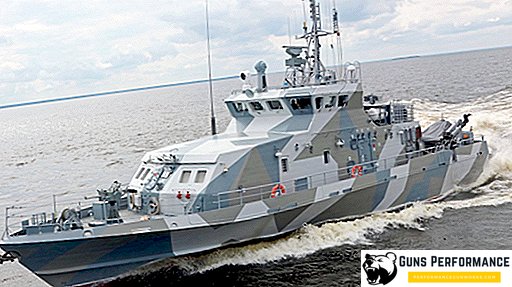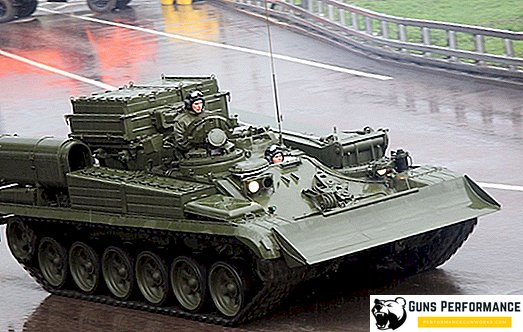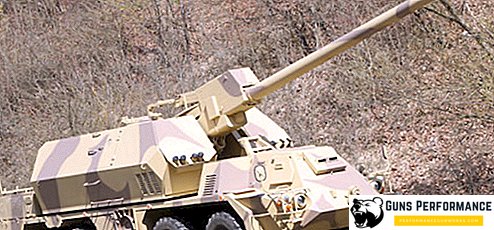When reviewing Soviet films about the Second World War, one might get the impression that the German army was armed with MPL-40 submachine guns, which for some reason were called Schmeisser. But this is not true. In the German infantry division, only 312 soldiers were armed with an MR-40. The main weapon of the German infantryman near Moscow and Stalingrad was a rifle (or rather, a carbine) Karabiner 98k. It is very likely that with the same weapon their fathers had risen to attack somewhere near Verdun or Somme twenty years before.

After all, Karabiner 98k is nothing more than a modification of the famous Mauser Gewehr 98 infantry rifle, which went through the entire World War I together with the Kaiser army.
Among the hundreds of samples of weapons created in the last century, there are few samples that would have been in the service for nearly five decades. It is even harder to recall the examples of weapons that participated in two world wars at once. Among the shop rifles, the very similar fate of the Russian "trilinek", which was adopted at the end of the XIX century and went along with the Russian and Soviet armies two world wars. The debate about which of these magazine rifles is still the best.
History of creation
The Mauser rifle, which we know under the name Mauser 98k, was released in 1935, but it was only a small upgrade of the rifle, launched in 1898. This weapon turned out so successful that it served more than half a century. The letter k at the end of the abbreviation means the German word Kurz, which means "short."
In 1898, the Mauser brothers were already recognized gunsmiths, the company created by them, enjoyed an excellent reputation. Their products were in service with not only Germany, but also other armies of the time: Spain, Turkey, Belgium.
The development of a new rifle began in 1871, that year Gewehr 1871 (Gew.71) was released. The product turned out very successful, and the Prussian military ministry placed an order for one hundred thousand units of a new rifle. The rifle came out so good that in the following years orders fell one after the other. Different countries put forward their requirements for a new weapon, which led to the appearance of several types of rifles, which, however, did not differ too much among themselves.
In the end, the brothers decided to collect all the successful innovations that emerged as a result of many years of work on various modifications of Gew.71. In addition, several years before, the company had created a new, very perfect for that time, cartridge of 7.92x57 mm, without a protruding flange on the sleeve. During the work, several calibers cartridges were tried, but the choice was made in favor of the 7.92x57 mm ammunition. It was these works in 1898 that led to the creation of the new Mauser Gewehr 98 rifle, which was in many ways similar to other samples of similar weapons from this period.
This weapon was adopted by the German army as a single weapon for infantry units. Moreover, the rifle turned out so successful that it was soon put into service in most countries with which the Mauser brothers had worked before. In 1899, the production of hunting rifles based on the Mauser Gewehr 98 began, and they also became very popular. The high barking strength of the barrel made it possible to use even the most powerful cartridges that existed at that time.
Over the following years, improvements were constantly made to the design of the rifle, new modifications were created. In 1902, the Radfahrer-Gewehr 98 rifle was created for scooters, it was distinguished by a curved stem of the bolt handle.
Already during the First World War (in 1915), a sniper modification of the Scharfschiitzen-Gewehr 98 rifle appeared, which also had a curved bolt and special mounts for a telescopic sight. In 1915, it was decided to select the most accurate rifles for mounting sniper sights on them, and more than 18,000 such modifications were made before the end of the war.
In 1908, a modification of Kar.98a was produced, which was developed for a pointed bullet with the best ballistics. This rifle had modified sights. Although Kar.98a was considered a carbine, it did not differ from the Gewehr 98 either in the barrel length or overall dimensions. The fact is that at that time the Germans considered any rifle adapted for use in cavalry as a carbine. The main difference in this case was the method of fastening the belt, which in Kar.98a was different from the standard rifle.

Very interesting modification, which is called the "trench Mauser." It is also the brainchild of the First World War. A sector magazine with a capacity of twenty cartridges was installed in this rifle. This weapon was specially developed for assault units, the soldiers of which complained about the insufficient capacity of the standard store. However, it turned out that such a store was not very convenient: it often clung, broke the balance of the weapon and increased its weight.
In 1914, not having survived a few months before the start of World War I, one of the designers of the rifle, Peter Paul Mauser, died without seeing the finest hour of his brainchild. After that, no major changes were made to the design of the Mauser Gewehr 98.
In 1923 another modification of the rifle appeared - Kar.98b, and twelve years later - Kar.98k, which is the most famous and most popular. Kar.98k (Karabiner 98k, Mauser 98k, K98k) was officially adopted in 1935 and became the main weapon of the infantry units of the German troops in World War II. On this weapon, a slide lag was applied, and the barrel length was also shortened to 600 mm. At the same time, on the basis of the Mauser 98k carbine, a sniper modification Zf.Kar.98k was created, which, after a number of improvements (mainly related to the sight), became the main weapon of the German snipers in world war.
Interestingly, the creation of the Mauser 98k was the result of not only technical, but also political decisions. The fact is that after the end of the First World War, the Germans were forbidden to have a rifle in service. Under the terms of the Versailles Peace, they could only use carbines. The Germans called all the Mauser Gewehr 98 rifles they had left with Karabiner 98b carbines, changing their aiming devices, bent the bolt handle and replaced the method of fastening the belt. Allies did not pay special attention to this German cunning.
During the war, some changes were made to the design of the Mauser 98k rifle, the purpose of which was to simplify and cheapen its production. For example, for the manufacture of a box and a butt, they began to use not a walnut tree, but pressed plywood, which increased the weight of the weapon by 300 grams. Some parts began to be produced by cold stamping, spot welding was introduced, several sights were simplified, the wooden lining of the bayonet-knife was replaced with bakelite. Although, it should be noted that these changes had no special effect on the characteristics of the weapon.

The Mauser 98k carbine replaced the Mauser Gewehr 98 rifle, as well as the Karabiner 98a and Karabiner 98b carbines. This weapon was produced until the end of the war, all were made more than 14 million copies. The rifle was in service with the armies of the Federal Republic of Germany and the GDR after the end of World War II, and it is still used in the Bundeswehr to carry a guard of honor. Over the years, Mauser 98k was in service in the armies of more than two dozen countries of the world, it was everywhere considered a very effective and reliable weapon.
Description of the weapon design
Mauser 98k is a magazine rifle with a rotary, longitudinal sliding gate. Rotate the bolt 90 degrees when locking the barrel, it has as many as three lugs, which provides extremely strong locking. In addition, there is a special vent in the gate, which, when breaking down powder gases, leads them down to the magazine cavity.
The shutter can be easily removed from the rifle, it does not need special tools. To remove, just pull the special lock and remove the bolt back.
One of the features of the Mauser 98k slide is a massive and very reliable ejector that extracts the liner from the chamber.
Shock-trigger udarnikovogo type, drummer cocked when turning the handle during the opening of the shutter. In the back of the gate is a fuse that has three positions. About the fuse can only say that it is very convenient. One horizontal position blocks the shutter, with the vertical position the shutter is free, with a different horizontal position you can shoot.
The fuse design is a definite advantage of the Mauser 98k carbine. The raised flag clearly indicates to the soldier that shooting is impossible, in addition, he is very ergonomic and comfortable, and you can easily cope with his gloves.
Mauser 98k has a long and smooth running of the trigger, for which snipers loved this weapon.

Power rifle comes from the store with a capacity of five rounds. About him should say a few words separately. The store on Mauser 98k is double-row, box-shaped and non-removable, it is completely in the box. The cartridges in it are staggered. Designers rifles Mauser Gewehr 98 and Mauser 98k managed to ensure that the store is absolutely not in favor of the dimensions of the weapon. It is very convenient for its use and distinguishes the Mauser 98k from most rifles of that time.
The German gunsmiths were able to achieve similar results by using a 7.92x57 mm cartridge, the sleeve of which did not have a flange, and also using the "chess" arrangement of cartridges in the store. A 7.62 × 54 mm R cartridge that was used in the Russian “trilinear” had a flange on the sleeve, which increased the size of the magazine, and also created problems when extracting the sleeve from the weapon.
To equip rifle Mauser 98k it was possible both by means of a holder, and on one cartridge. Manual insertion of the cartridge into the chamber was strictly prohibited.

Sights Mauser 98k consist of a normal pillar and front sight. Dovetail-type front sight, adjustable. The sight was on the trunk, it was regulated at distances from 100 to 1000 meters.
The bed is wooden, with a pistol grip. Butt has a steel back plate. At the beginning of the war, the bed and butt were made of walnut, then more and more often stamped plywood was used to make the bed. In the butt was made a special recess for storing supplies.
Both Mauser Gewehr 98 and Mauser 98k were completed with bladed-type bayonet-knives, which were attached to a special tip of the bed. In Germany, seven types of bayonet knives were developed (these are only basic types) for this weapon. The standard bayonet for the Mauser 98k carbine was SG 84/98, which was significantly shorter and lighter than that of the Mauser Gewehr 98. The importance of bayonet combat during World War II was significantly reduced, therefore, since 1944, the carbines stopped completing bayonet-knives.
Differences Mauser Gewehr 98 and Mauser 98k
The differences between these models of small arms were not too large, they can hardly be called fundamental. Here are the main ones:
- The Mauser 98k has a shorter stem;
- the Mauser 98k has a downward-curved shutter handle, less than the length of the box, it has a notch for the shutter-handle;
- the carbine had a special ("cavalry") fastening of the belt;
- on the Mauser 98k a slide delay is used.

The main advantages of the Mauser 98k carbine compared to the Mosin rifle
So which rifle is better: the German Mauser 98k or the Russian "trilinek"? They were developed at about the same time, had a similar cartridge caliber and characteristics.
The German rifle has a number of undeniable advantages: it is more convenient, there is no protruding magazine in it, the fuse is very ergonomic. It should be noted cartridge, which was used on the Mauser 98k. It is the absence of a flange on the sleeve that has provided many advantages to the rifle.
The disassembly of the German rifle was simple and did not require additional tools.
In addition, the Mosin rifle had a less convenient butt, which was more suitable for bayonet combat than for accurate shooting. When reloading the rifle should have been taken away from the shoulder butt, which lowered the rate of fire and knocked down the sight. "Trilinek" had a tight and long descent, not conducive to improving the accuracy of shooting. The Russian rifle had to be shot with a bayonet, otherwise the point of impact was shifted to the side, but wearing a rifle with a bayonet was always very inconvenient. Over time, the bayonet loosened, which significantly reduced accuracy.
The frame holder, which was used on the trilinear, did not contribute to the loading speed in battle.
These are only the main disadvantages of the Mosin rifle. Yes, it was very reliable, had a powerful cartridge and was easy to manufacture. But at the beginning of the First World War, it was not the most modern, at the time of the start of the Second World War, it can be safely called obsolete.
Specifications
| Model | Mauser Gewehr 98 | Karabiner 98k |
| Manufacturer | Mauser-Werke A.G. | |
| Cartridge | 7.92 × 57 mm Mauser | |
| Caliber | 7.92 mm | |
| Unloaded weight | 4.1 kg | 3.7 kg |
| Weight with ammo | n / a | |
| Length | 1250 (with 1500 bayonet) mm | 1,100 (with bayonet 1340) mm |
| Barrel length | 740 mm | 610 mm |
| The number of rifling in the trunk | 4 right | |
| Trigger mechanism (trigger) | Udarnikovogo type | |
| Operating principle | Sliding shutter | |
| Fuse | Flag | |
| Aim | Front and rear sight | Front sight with ear muff and rear sight |
| Effective range | 500 m | |
| Sighting range | 2000 m | 1000 m |
| Initial bullet speed | 878 m / s | 860 m / s |
| Type of ammunition | The intimate double row store | |
| Amount of cartridges | 5 | |
| Years of production | 1898-1945 | 1935-1945 |












